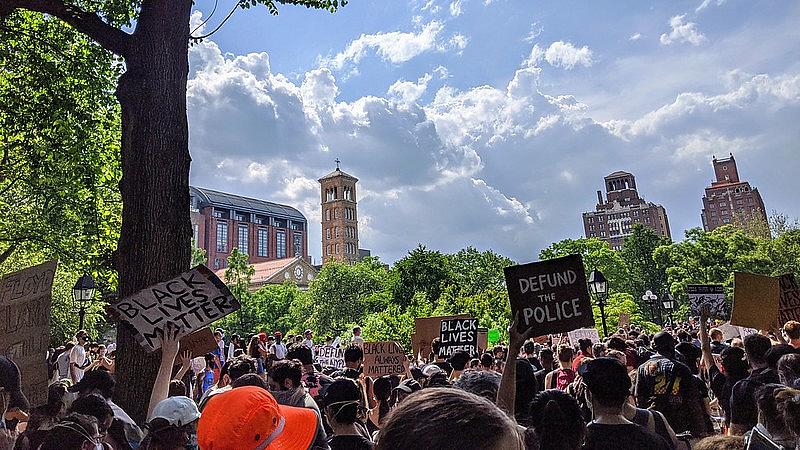What it means to defund the police — and why journalists should follow the money

Photo by Eden, Janine and Jim via Flickr
The United States spends twice as much on policing and prisons as on social services. There’s a better way to keep communities healthy and safe, and people closest to the pain of police brutality are showing the way.
In Oakland, California, with leadership from the Black Organizing Project, the school board passed the George Floyd Resolution to Eliminate the School Police Department. In Minneapolis, the majority of the city council voted to dismantle the police department and invest in a community-based public safety model, while the school board finally listened to youth and parent organizers and canceled its contract that paid for city police to be stationed in schools.
Advocates are focusing their strategies on budget approval processes, which are usually routine. But amid nationwide protests over the police killing of George Floyd and a pandemic that has disproportionately harmed people of color, government leaders are being held to account for budget priorities that spend far too much on racially motivated policing and punishment, and far too little on what communities really need to be safe, healthy, and prosperous.
Budgets are much more than numbers. They represent a social contract that reflects our collective moral priorities and values. We contribute our tax dollars in exchange for services and investments that advance our social goals. When Black Lives Matter organizers call for defunding police, they’re saying this contract is horribly broken for Black people.
The United States spends twice as much on law and order as on social services such as food support and cash assistance for families in need, according to a 2019 book, The Triumph of Injustice: How the Rich Dodge Taxes and How to Make Them Pay, by UC-Berkeley economists Emmanuel Saez and Gabriel Zucman. At PolicyLink, the Oakland-based research and action institute where I work, my colleague and I recently examined how these spending priorities have led to today’s crises in justice, health and employment.
Journalists can shine a light on government budgeting and bring transparency to what are arguably the most important decisions that public officials make. How much goes to law enforcement and punishment and how much to public health, youth programs and social services? How are policymakers trying to balance the books as revenues plummet during the pandemic? Do their decisions reflect or contradict the values and needs of the community? A new database, compiled by Vera Institute of Justice, makes it easy to look at the cost of policing in the nation’s 72 largest cities.
Police spending is typically the largest line item in a city’s budget, and a closer look at law enforcement spending plans can be illuminating. For example, the Boston police department spent more than $200,000 on military-style equipment such as sniper rifles in the first five months of 2020, according to The Boston Globe.
It’s encouraging to see cities responding to calls to reduce police spending, but it’s important to examine whether proposals are substantive or just window dressing. For example, in California’s San Mateo County, the Board of Supervisors approved a resolution recognizing the Black Lives Matter movement and then went on to authorize the purchase of nearly $1 million worth of Tasers. The use of these weapons had been widely criticized after San Mateo County sheriff’s deputies killed three people with Tasers in 2018, including Chinedu Okobi, a mentally ill Black man.
There are also great stories to tell about community advocates who have been pushing to defund the police long before that phrase entered mainstream media coverage. For example, in late June the Sacramento City Unified school board ended its contract with the Sacramento Police Department, which paid for officers to patrol school campuses. But long before that vote, youth and parent organizers from the Black Parallel School Board and Brown Issues had set the stage by making the case for why school police did more harm than good.
Advocates are focusing attention on the key question in this moment: What really keeps communities safe, healthy and prosperous? As communities of color confront the dual crisis of police brutality and the COVID-19 pandemic, what they need most are extraordinary investments in health, housing, education, jobs, and social services, not austerity measures or more spending on “law and order.” Philadelphia’s proposed Black stimulus package is an example of a more comprehensive approach that other cities should consider — and that journalists can write about.
Without greater analysis of racial equity in current spending, it is farfetched to think that governments will resolve historic racial inequities. Without growth in revenues, we are unlikely to see game-changing investments that protect and support the most vulnerable.
Budgets hold the key. Policymakers can create more opportunity and safety for Black people and all people by prioritizing these investments and targeting their impact to support the most vulnerable communities. And journalists can perform a vital function by following the money.
Marc Philpart is a managing director at PolicyLink, a national research and action institute working to advance racial and economic equity.

